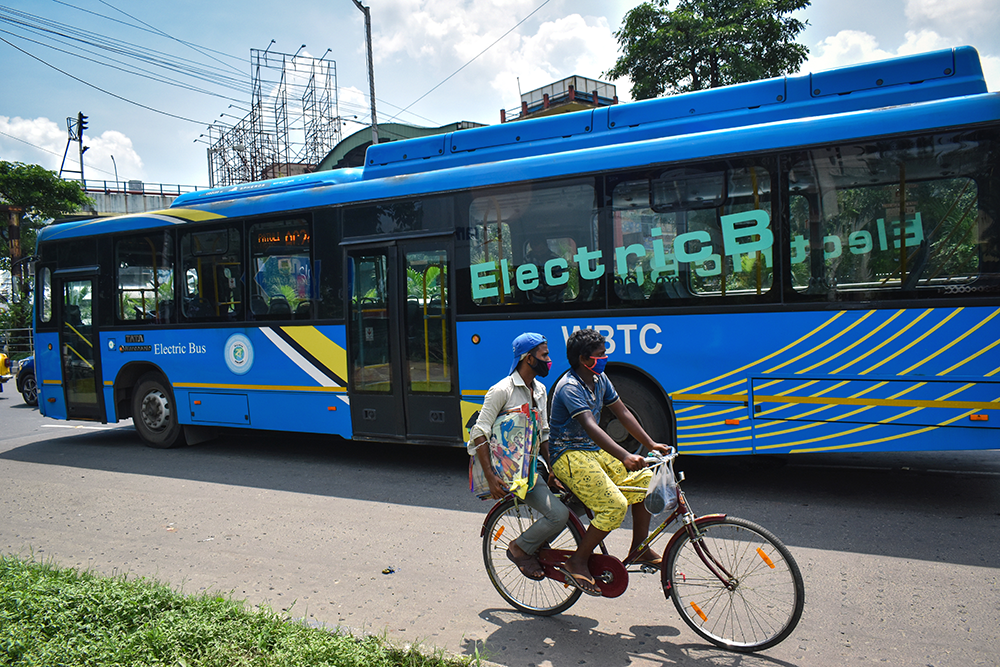India: Electrifying Public Transportation in Kolkata

With the rapid acceleration of the Indian automobile markets, electric vehicles have massive potential for improving air quality in Indian cities which is expected to grow to a population of 590 million by 2030. Electric vehicles can reduce the pollution caused by, and, coupled with renewable energy, contribute to curtailing greenhouse gas emissions from automobiles. They can also meet future demand for public transportation and provide better energy security through reduced oil imports while generating new economic opportunities. IFC estimates that the investment opportunities in electric vehicles (EVs) in India could be as high as $667 billion by 2030.
PPIAF is working with the West Bengal Transport Corporation in introducing EVs starting with Kolkata’s public bus fleet. A PPIAF-funded diagnostic found that replacing 5 percent of the conventional bus fleet with electric buses can reduce CO2 emissions by 3,094 tons annually. With West Bengal Transport Corporation planning to increase the city fleet to 5,000 e-buses by 2030, CO2 emissions in Kolkata can be reduced by 782,560 tons per year. Under this scenario, the government would set up 241 EV charging stations across Kolkata. Kolkata introduced its electric tram line in 1902—the first in India. As the city grew, gasoline-powered buses and three-wheeled rickshaws replaced them. Pollution, however, has become a severe problem. A World Health Organization analysis of pollution levels in megacities between 2010 and 2016 found that the Kolkata metropolitan region was the second-most polluted in India after Delhi.
Electric vehicles offer an opportunity to address this problem, both for mass transit in the city and for the growing number of automobile owners. The foundation for accelerating EV deployment is in place: the state government provides regulatory support; the city’s power supplier is reliable; and, the city’s direct-current (DC) power network, which services the city’s tram system, can be used to set up fast-charging stations for public transport vehicles. The city has also taken steps to prepare a roadmap for transitioning to a low-carbon future.
PPIAF’s contribution
The World Bank is working closely with the state-owned West Bengal Transport Corporation, which runs Kolkata’s bus, tram, and ferry services, to accelerate the adoption of EVs in the city. In October 2017, the Bank provided policy and tariff recommendations for the electrification of public transportation in Kolkata. Following this, the state government of West Bengal’s Transport Department requested World Bank Group support to build its institutional capacity and undertake a sustainable transition to cleaner public transportation in the city.
Private investment in the infrastructure will be necessary to enable the widespread use of EVs for personal and mass transportation, which will help Kolkata achieve the goals outlined in the implementation plan. PPIAF worked closely with World Bank transport specialists and ESMAP, a partnership between the World Bank and donor partners, to attract private sector participation in Kolkata’s EV public transportation system.
PPIAF and World Bank Group designed a rigorous diagnostic to identify challenges to deploying EVs and charging infrastructure in Kolkata. Based on the diagnostic, PPIAF helped develop a suite of interventions articulated in a program implementation roadmap that includes policy and tariff design, business models for EV operations, charging standards, vehicle grid integration, and social and environmental considerations. The Transport Department in West Bengal will now take these efforts forward to improve urban mobility that is socially inclusive, energy-efficient, and friendly to the environment.
PPIAF, ESMAP and the World Bank benefit Kolkata and other Indian megacities that suffer from heavy air pollution. Kolkata is providing a viable model for mainstreaming electric mobility in large, developing cities. To support knowledge sharing in this space, PPIAF facilitated a seminar with the West Bengal Transport Corporation to exchange experience in advancing electric mobility with other Indian states.
The impact in Kolkata—and beyond
Today, the West Bengal Transport Corporation is electrifying its public transport network. It procured 80 electric buses, selected bus depots and bus terminals to support fleet operations, and procured electric buses for five other cities in the state. A private-sector operator is being chosen to procure 100 more electric buses through a transparent bidding process.
The private sector is also benefitting. Lithium Urban Technologies (LUT), the largest EV fleet operator in the B2B sector in India, expanded its operations from Bangalore to Kolkata. LUT, an IFC client, is also setting up an EV charging hub in the city in partnership with Fourth Partner Energy, a charging infrastructure company. The hub is the largest in India. LUT plans to upgrade corporate fleets, which currently run on diesel, with EVs over the next few years—in Kolkata, this will reduce by 10,000 million tons, annual CO2 emissions and create more than 3,000 jobs.
Because of this initiative, Kolkata was recognized as the first city in India to win the prestigious C40 Cities Bloomberg Philanthropies Award in 2019.
Sources: ESMAP Impact Story; Implementation Plan for Electrification of Public Transportation in Kolkata.

An Electric bus seen on Kolkata's Street. Editorial credit: papai / Shutterstock.com

